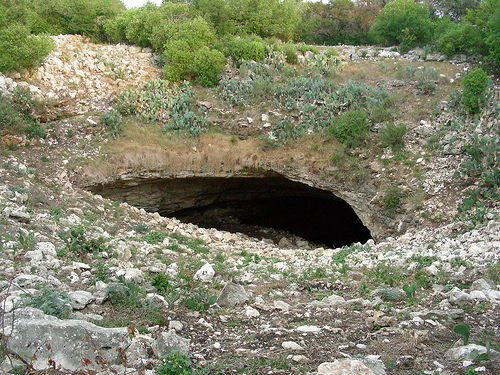BatsLive! Registration Underway for Sept. 18 First Live Public Education Web Broadcast

Visitors gather at Bracken Cave near San Antonio, Texas, to experience the nightly flight of millions of Mexican free-tailed bats. A public education webinar is set for Sept. 18. Registration is free. Photo courtesy of: Bat Conservation International
Want to know more about one of the most beneficial, yet misunderstood mammals on earth? Learn more about the amazing life of bats including the home of the world’s largest bat colony as the U.S. Forest Service co-sponsors a live distance learning web broadcast on Sept. 18.
Bat educators will share their knowledge about the 22 million Mexican free-tailed bats that make their summer home in Bracken Cave near San Antonio, Texas. Bat experts will share stories about bat life and the many benefits they provide as part of the BatsLive! Distance Learning Adventure webinars. Participation in the first live broadcast from the cave is free but participants are encouraged to register for the programs at www.batslive.pwnet.org.
“This free evening education program will offer children a chance to see an unforgettable sight as millions of bats will spiral out of the cave at dusk for their nightly insect hunt,” said Forest Service Chief Tom Tidwell. “Please join us and learn more about the vital role bats play in our lives.”

Bracken Cave near San Antonio, Texas, harbors one of world's largest colonies of Mexican Free-tailed bats, May 2011. Each evening during the summer more than 20 million bats emerge from the cave to feed on night-flying insects, many of which are pests to nearby crops. Photo courtesy of: Dennis Krusac
Bats consume tons of forest and agricultural pests each year, reducing the need for pesticides and offer savings of up to $57 billion a year for farmers alone. They are vital to healthy ecosystems and human economies worldwide. More than two-thirds of bat species hunt insects and a single little brown bat can eat up to 1,000 mosquito-sized insects in just one hour. However, they are rapidly losing their habitat. The webinar will explain what you can do to help bats thrive, whether in your own backyard, your community or on your neighboring public lands.
Visit the BatsLive! web site for more bat facts as well as photos, lesson plans, and links to bat conservation partners and up-to-date information about white-nose syndrome, a condition linked to the deaths of more than a million hibernating bats from New Hampshire to Tennessee. The cause of the bat deaths remains unknown despite the continuing search to find the source of this condition by numerous laboratories and state and federal biologists. A teacher webinar on caves and karst will also be offered Oct. 11.
